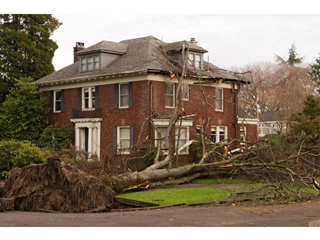
Storms can have a devastating impact on communities. Not only do they put our safety at risk, they can also cause significant damage to our homes. According to Climate Coalition, an organisation dedicated to action against climate change in the UK, England has experienced a major flood almost every year since 2007. In total this has damaged approximately 100,000 properties.
So, if your home has been damaged through a storm, will your insurance cover the repairs? This and other factors you’ll need to consider, are discussed below.
It’s highly likely that your home insurance policy provides cover against storm damage. It’s become something of a myth that insurance companies won’t pay out in the event of a storm or “an act of God”, but in today’s world this has become increasingly unlikely.
The Association of British Insurers (ABI) reported that insurers paid out nearly £500 million in claims in the aftermath of Storms Dudley, Eunice and Franklin over the 2021/22 winter period. They also forked out an estimated £543 million in damages caused by Storms Ciara, Dennis and Jorge in February 2020.
“Storms and floods are exactly the type of unwelcome event that insurance protects against,” said Sarah Brodie, Senior Policy Adviser at ABI.
However, it’s always important to review your own policy documents to gauge your level of cover. Some insurers won’t pay out if your home was already in poor condition while others won’t cover damage to your garden plants.
It also goes without saying that you’ll need to consider your type of cover, and whether you opt for just buildings or contents insurance. Buildings insurance should cover you for any structural damage storms cause to your home, while contents insurance should cover any damages to your personal belongings. For example, if a storm damages your garden furniture, and it’s listed under your contents insurance, your provider will cover the replacement costs.
Not happy with your current level of storm cover? Compare the best home insurance policies today by using our site.
According to the Financial Ombudsman Service, many of its disputes centre on what constitutes a storm. To investigate these complaints, the organisation usually uses officially logged weather reports to determine the case.
That’s why ABI classifies a storm as a violent weather period with gusts of at least 48 knots, or 55 miles per hour. If your insurer measures storms on the Beaufort scale it will need to reach level 10.
Otherwise, a weather pattern can still be considered a storm if one of the following apply:
While damages caused by storms could run into thousands of pounds for some people, it will cost a lot less for others. In fact, the cost may be lower than your excess and it could make more sense to foot the bill for these damages yourself.
Some insurance providers reward their policyholders for not claiming by providing a discount on their premiums. If this is included on your home insurance policy is it worth protecting your bonus by not claiming? Our guide What is a no claims bonus and is it worth protecting? explains.
This is why you should evaluate the damages made to your home after the storm has passed to assess the true cost. Below we’ve listed what some of these damages might include:
During periods of heavy rain, water can escape through cracks in your roof and into your home. This can damage your contents, such as your sofa or television to name a few.
Heavy snow can add excess weight to your roof and therefore damage its structural integrity.
Violent winds can force trees to fall on your property, potentially putting repair costs into thousands of pounds. In such an instance, if your home becomes uninhabitable it’s worth checking with your insurance provider if they’ll cover the cost of alternative accommodation.
While most unlikely to occur out of all listed damages, lightning can shatter glass or create a fire hazard to your property.
Besides the potential damages we’ve listed above, you may be more concerned about whether your home insurance policy provides cover for flooding. This is not a given, and is an important level of cover you’ll need if you live in a high-risk area.
It’s important to check your policy document to see if the level of flooding cover you currently hold is sufficient.
Damages to your car should be covered by your car insurance policy. It’s rare for a third party or your home insurance policy to cover damages to your car as a direct result of a storm.
In most policies, damages to your fence and gates are covered by your insurer. However, it’s commonplace for some providers to not cover damages to gates and fences due to storm damage.
If you’re certain that you want this added on to your policy it’s best to speak to your provider directly.
If you know a storm is imminent, it’s often worth spending some time preparing your home for possible weather-related damages. This has the added benefit of proving to your insurance provider that you’ve taken steps to keep your home in good condition, something which works in your favour if there are any disputes over your claim. Such work can include, but is not limited to:
Disclaimer: This information is intended solely to provide guidance and is not financial advice. Moneyfacts will not be liable for any loss arising from your use or reliance on this information. If you are in any doubt, Moneyfacts recommends you obtain independent financial advice.